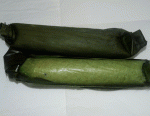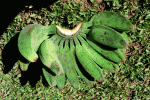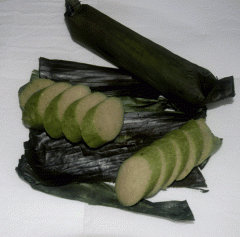Rare Receipes - Lontong Daun Pisang Sematu
Apr 17, 2009
'LONTONG' done traditionally is rarely found nowadays; at least in the cities. Some people are using plastic bags and green coloring! Before the traditional way is lost forever, here's the method:
Use only leaves from the banana plant called 'sematu' or 'batu' or 'nipah'. Using leaves from this banana cultivar will impart a deep green color to the rice and a wonderful fragrance. Leaves from other banana cultivars can be used but the color will be lacking, and the aroma is not as fragrant. Try to get leaves from an organic farm as fungicides are used extensively in banana cultivation especially if they are using tissue-cultured clones.
The 'sematu' fruit is mottled, untidy and is 3-sided and angled.
The 'sematu' banana plant is tall, at our farm it reaches to 20 feet high. We grow the plant to provide shade for the chickens in the fields. The fruit tastes better fried or cooked and is seldom eaten raw.
The 'heart' or male flower of the 'sematu' at our farm is big, easily 18 inches long.
Use 2 or 3 layers of the leaves. Use a narrow cylinder as a mould and roll the leaves. Make sure the overlap errs on the generous side so that the expanding rice will not cause the ends of the leaves to open up. Remove the mould. Close one end of the rolled leaves with tooth picks or if you intend to keep the lontong for a few days, stitch it up. This is to prevent the rice during storage, from going moldy by exposure to air.
This is to prevent the rice during storage, from going moldy by exposure to air.
The 'sematu' leaf gives a rich green color to the cooked rice which should be glutinous-like after cooking and no longer seperates into individual grains.
Fill the rolled leaves to 30% to 40% of its length with rice. You may have to try out one cylinder first as different rice have different expansion rates. You want the rice to expand and get 'compressed' within the rolled leaves. Secure the other end.
Put the rolls into a stainless steel pot and boil for 3 to 4 hours. Do not use an aluminum pot as the greenish color will be faint due to some reaction with the leached aluminum. Take out the lontong and let drain. After it has cooled, serve. Kept in a cool dry place, it can keep for 3 days. Kept in the refrigerator it can keep for up to 10 days.
Serve with curries, with rendang, or with Chinese stews, for example those with chicken or goat pieces stewed with black soya sauce, mushrooms, garlic and herbs. Another interesting dish is lontong with grated coconut and gula melaka or palm sugar.




The comments are closed.